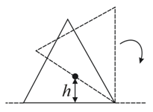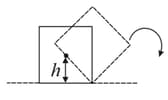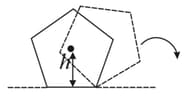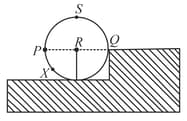A uniform circular disc of mass and radius is rotating with an angular velocity of about its own axis, which is vertical. Two uniform circular rings, each of mass and radius are gently placed symmetrically on the disc in such a manner that they are touching each other along the axis of the disc and are horizontal. Assume that the friction is large enough such that the rings are at rest relative to the disc and the system rotates about the original axis. The new angular velocity (in ) of the system is

Important Questions on Rotational Mechanics
the following equation, , where and At, which of the following statement (s) is are true about the particle?
Consider regular polygons with number of sides as shown in the figure. The centre of mass of all the polygons is at height from the ground. They roll on a horizontal surface about the leading vertex without slipping and sliding as depicted. The maximum increase in height of the locus of the centre of mass for each polygon is . Then depends on and as



A wheel of radius and mass is placed at the bottom of a fixed step of height as shown in the figure. A constant force is continuously applied on the surface of the wheel so that it just climbs the step without slipping. Consider the torque about an axis normal to the plane of the paper passing through the point . Which of the following options is/are correct ?

In the List-I below, four different paths of a particle are given as functions of time. In these functions, are positive constants of appropriate dimensions and . In each case, the force acting on the particle is either zero or conservative. In List-II, five physical quantities of the particle are mentioned: p is the linear momentum, L is the angular momentum about the origin, is the kinetic energy, is the potential energy and is the total energy. Match each path in List-I with those quantities in List-II, which are conserved for that path.

